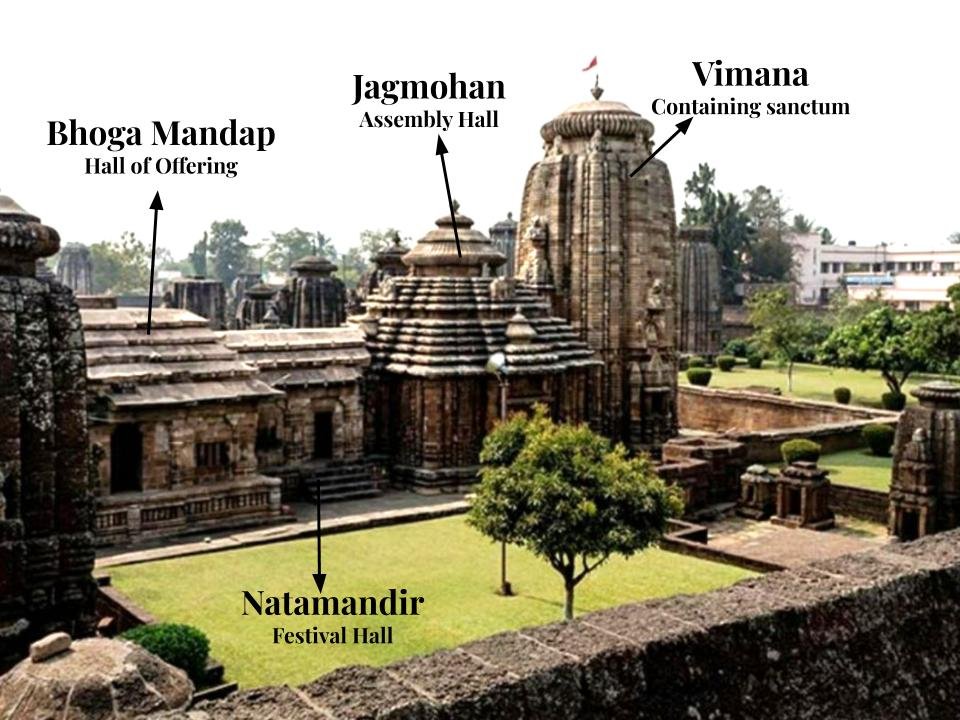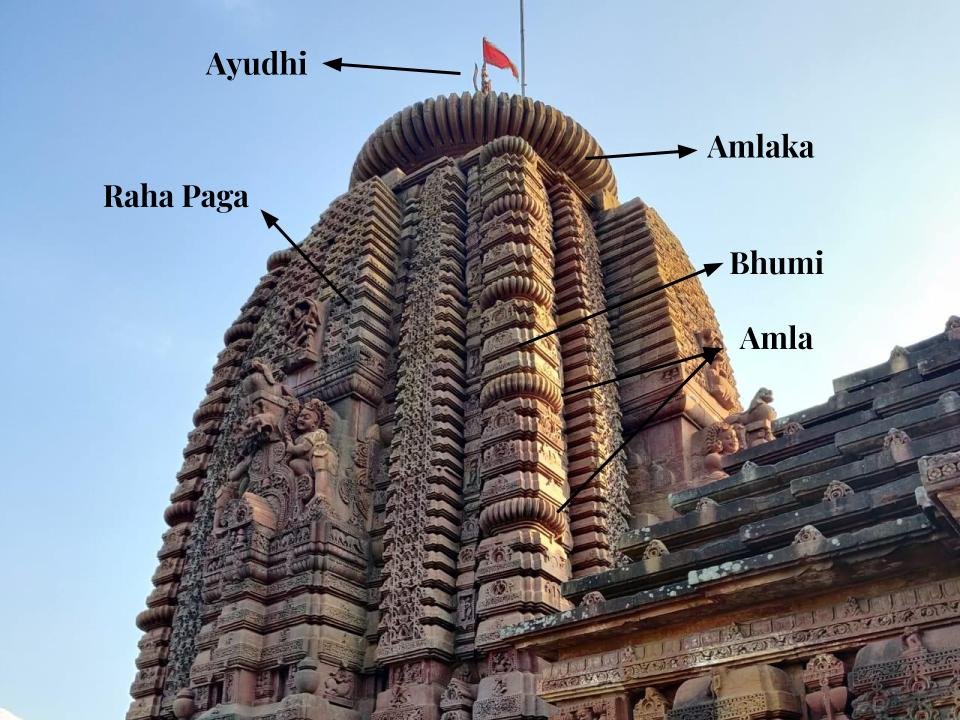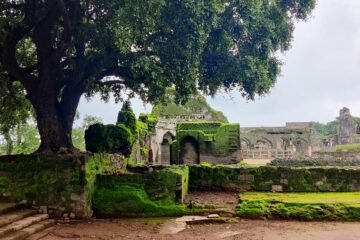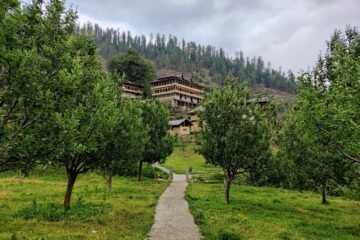The Evolution of Odisha's Temples
Odisha’s temple architecture falls under the Kalinga style of temple architecture, named after state’s Kalinga dynasty. Before we start off with our tour of temples in Bhubaneshwar, let’s take a brief look at some important basics of this style. The Kalinga style of temple architecture started with inspiration from the North Indian Nagara style of temple architecture. It is a magnificent form of architecture and has developed in a span of 700 years, starting from around 600 CE in the form of very basic temples, to reaching the zenith of its development in 1300 CE. Like all things ‘under development’, the temples too started off as simple and then successively evolved- each temple more magnificent than its predecessor. Let’s see how this evolution happened in the form of some basic concepts.
1. Basic Parts of a Kalinga Temple
A typical temple of Kalinga Style of Temple Architecture has four parts:
- Vimana: This is the tall structure containing the sanctum or main shrine of the principal deity of the temple. It is the tallest structure of the temple and in Odisha, mostly has a curvileanear structure.
- Jagamohana: Jagamohan is a rectangular structure which functions as an assembly hall. In typical Odisha temples, it has a pyramidal roof.
- Natamandira: Natamandir is a festival hall. This dancing hall was where the devadasis danced and dedicated their lives to dance forms like Odissi.
- Bhoga-mandapa: Bhoga-mandapa is the hall of offerings.

As you can see, these components are all built in a straight line.
However, these four components have only developed after the 700 year-long evolution that we have mentioned above. The earliest temples like Laxmaneshwara, Bharateshwara and Shatrughaneshwara temples in Bhubaneswar have the vimana only. Later temples had the main assembly halls called jagamohan as well, which mostly has a pyramidal roof. As the complexity of the temple functions grew, so did the parts of the temples. And later Kalinga temples saw the addition of two more parts- the Natamandira (festival hall) and the Bhoga-mandapa (hall of offerings).
2. Styles of Temple Architecture
The structures of Odisha temples are mostly divided into three types based on the shape of their architectural features.
- Rekha Deula: These structures are curvilinear in shape. The major portion of the structure is cylindrical in shape, while the top portion converges. Majority of Odisha temples are of this type.
- Bhadra/Pidha Deula: The bhadra/pidha structures have pyramidal roofs. Each successive layer of the roof (called pidha) is smaller (roughly half) than the one below it. Usually the jagamohan, or assembly halls, were built in this style in Odisha temples.
- Khakhara Deula: These structures are oblong in shape with a wagon-vault roof. Take a look at the image below to understand what this looks like. Very few of such temples are found in Odisha.

3. Ratha and Paga in a Temple Plan
Ah, now this part is difficult to explain. This concept took me hours to understand. I’m going to need you to use your imagination and three dimensional spatial sense a little for this.
In Kalinga temple architecture plans, the vimana is usually square in its basic shape. But some vertical projections (see images below) called paga are added to make the structure richer architecturally. To a layperson like myself, these look like vertical pillars merged into the wall of the vimana. In Odisha temples, each projection is beautifully carved.
But we have been talking three-dimensionally till now. These same vertical projections called paga, during the planning stage of the temple, are drawn in a two-dimensional form. Each vertical offset projection in this two-dimensional form is called ratha (see line diagram below).
Based on the evolutionary stage of temples amongst other factors, temples could be triratha (three vertical projections), pancharatha (five vertical projections), saptaratha (vertical projections) and so on. The early Odisha temples were triratha in structure.

As you can see from the images above, in the Kalinga style of temple architecture, each vertical projection or paga is beautifully carved. In fact, each paga has its own distinctive function in adding to the meaning and beauty of the temple. The main paga, called the raha paga, is at the centre of every side of the vimana. One of these raha pagas becomes the temple entrance, whereas the other three usually contain niches, as shown below. Niches often carry sculptures of the subsidiary gods of the temple.

The other subsidiary paga are called anuraha and kanika paga.
4. The Temple as a Human Body
The artisans who created Kalinga temples considered the temple to be a human body. While the inner sanctum is considered the sacred womb (garbhagriha) of the temple, the temple construction externally is taken to be a male form. Roughly, there are four main parts- the pista (platform), the bada (vertical wall), the gandi (trunk) and the mastaka (the head or crown).
- Pista: The pista is a platform on which the temple is built. It is not present in many Odisha temples, especially the earlier ones.
- Bada: The bada is the wall. It symbolises the legs of the temple and consists of three parts: pabhaga (foot), jangha (thigh) and baranda (moulding)
Till now the structure of the vimana and jagamohan remains the same. The differences start in the shape the trunk portion takes. In rekha deula, we have:
- Gandi: The gandi, or trunk, is where rekha deula structures start forming a convex face. These are divided vertically into raha paga and subsidiary paga. The subsidiary paga are divided horizontally into sculptured sections called bhumis separated with each other with ribbed discs called amlas (named after the shape of the gooseberry or amla).
- Mastaka: The mastaka contains a disc called amlaka, over which is an inverted lotus shaped kalasha. Anointing the very top is either a flag or the ayudhi (weapon of the presiding deity of the temple).
Here are some parts that I could photograph during my tour to Mukteshwar Temple in Bhubaneshwar:

Whew, done! Now that we are done with these basics of Temple Architecture of Odisha temples, let’s start our Temple Tour of Bhubaneshwar.
References
- History of Odisha From Earliest Times to 1434 AD, Dr. Manas Kumar Das
- General introduction to Odishan Temple Architecture, Anjaliprava Sahoo, Odisha Review
- www.puratattva.in
- www.historyofodisha.in
- https://odishatourism.gov.in
- Ratha (Architecture), en.wikipedia.org




Beautifully described… Looky forward to read more about odisha heritage and culture.
Thank you so much Rutambhara! 🙂
*looking
[…] https://www.rachnakar.com/indian-temple-architecture-odisha-style/ […]